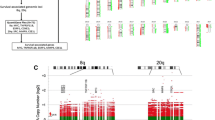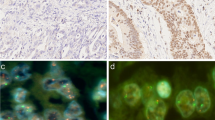Abstract
We searched for candidate target genes in metastatic gastric cancer, using comparative genomic hybridization (CGH) and mRNA expression array analysis of endoscopic biopsy samples collected from 32 patients. Recurrent amplicons included 17q21.2 (36,569,293–37,307,055), 8q24.13-q24.21 (126,357,475–130,159,285), and 20q13.33 (60,211,249–61,382,787). In this paper, we focused on the 1.1-Mb genomic region containing 24 genes in chromosome 20q13.33 (from 60,211,249 to 61,382,787), the third most frequent amplicon that was amplified in three of 32 patients (9.4 %), with log2 tumor/reference ratios ranging from 0.6 to 1.5. Of three genes in the 20q13.33 amplicon, ADRM1 was chosen for functional analyses. ADRM1 knockdown suppressed the proliferation of two human gastric cancer cells, SNU-601 and SNU-216. Overexpression of Adrm1 promoted cell proliferation of conditionally-immortalized, mouse ImSt gastric epithelial cells, with increased S1 phase fraction and decreased expression of p21(Cip1). These results collectively indicate that ADRM1 promoted gastric epithelial cell proliferation by cell cycle progression. Therefore, ADRM1 is a candidate target gene in the chromosome 20q13.33 amplicon that may possibly be linked to development of gastric cancer.



Similar content being viewed by others
Abbreviations
- CGH:
-
Comparative genomic hybridization
- EGFP:
-
Enhanced green fluorescent protein
- ANOVA:
-
Analysis of variance
- FISH:
-
Fluorescence in situ hybridization
- FFPE:
-
Formalin-fixed: paraffin-embedded
- FITC:
-
Fluorescein isothiocyanate
- FACS:
-
Fluorescence-activated cell sorting
- TMA:
-
Tissue microarray
References
Alberts S, Cervantes A, van de Velde C (2003) Gastric cancer: epidemiology, pathology, and treatment. Ann Oncol 14(Suppl 2):ii31–ii36
Kim HK, Green JE (2014) Predictive biomarker candidates for the response of gastric cancer to targeted and cytotoxic agents. Pharmacogenomics 15(3):375–384
Kim HK, Choi IJ, Kim CG, Kim HS, Oshima A, Yamada Y, Arao T, Nishio K, Michalowski A, Green JE (2012) Three-gene predictor of clinical outcome for gastric cancer patients treated with chemotherapy. Pharmacogenomics J 12(2):119–127
Kim HK, Choi IJ, Kim CG, Kim HS, Oshima A, Michalowski A, Green JE (2011) A gene expression signature of acquired chemoresistance to cisplatin and fluorouracil combination chemotherapy in gastric cancer patients. PLoS ONE 6(2):e16694
Cheng L, Wang P, Yang S, Yang Y, Zhang Q, Zhang W, Xiao H, Gao H, Zhang Q (2012) Identification of genes with a correlation between copy number and expression in gastric cancer. BMC Med Genomics 5:14
Fan B, Dachrut S, Coral H, Yuen ST, Chu KM, Law S, Zhang L, Ji J, Leung SY, Chen X (2012) Integration of DNA copy number alterations and transcriptional expression analysis in human gastric cancer. PLoS ONE 7(4):e29824
Tabach Y, Kogan-Sakin I, Buganim Y, Solomon H, Goldfinger N, Hovland R, Ke XS, Oyan AM, Kalland KH, Rotter V, Domany E (2011) Amplification of the 20q chromosomal arm occurs early in tumorigenic transformation and may initiate cancer. PLoS ONE 6(1):e14632
Husnjak K, Elsasser S, Zhang N, Chen X, Randles L, Shi Y, Hofmann K, Walters KJ, Finley D, Dikic I (2008) Proteasome subunit Rpn13 is a novel ubiquitin receptor. Nature 453(7194):481–488
Fejzo MS, Dering J, Ginther C, Anderson L, Ramos L, Walsh C, Karlan B, Slamon DJ (2008) Comprehensive analysis of 20q13 genes in ovarian cancer identifies ADRM1 as amplification target. Genes Chromosomes Cancer 47(10):873–883
Chen W, Hu XT, Shi QL, Zhang FB, He C (2009) Knockdown of the novel proteasome subunit Adrm1 located on the 20q13 amplicon inhibits colorectal cancer cell migration, survival and tumorigenicity. Oncol Rep 21(2):531–537
Yan F, Cao H, Chaturvedi R, Krishna U, Hobbs SS, Dempsey PJ, Peek RM Jr, Cover TL, Washington MK, Wilson KT, Polk DB (2009) Epidermal growth factor receptor activation protects gastric epithelial cells from Helicobacter pylori-induced apoptosis. Gastroenterology 136(4):1297–1307
Schreiner P, Chen X, Husnjak K, Randles L, Zhang N, Elsasser S, Finley D, Dikic I, Walters KJ, Groll M (2008) Ubiquitin docking at the proteasome through a novel pleckstrin-homology domain interaction. Nature 453(7194):548–552
Okamoto Y, Ozaki T, Miyazaki K, Aoyama M, Miyazaki M, Nakagawara A (2003) UbcH10 is the cancer-related E2 ubiquitin-conjugating enzyme. Cancer Res 63(14):4167–4173
Yao T, Song L, Xu W, DeMartino GN, Florens L, Swanson SK, Washburn MP, Conaway RC, Conaway JW, Cohen RE (2006) Proteasome recruitment and activation of the Uch37 deubiquitinating enzyme by Adrm1. Nat Cell Biol 8(9):994–1002
Hamazaki J, Iemura S, Natsume T, Yashiroda H, Tanaka K, Murata S (2006) A novel proteasome interacting protein recruits the deubiquitinating enzyme UCH37 to 26S proteasomes. EMBO J 25(19):4524–4536
Qiu XB, Ouyang SY, Li CJ, Miao S, Wang L, Goldberg AL (2006) hRpn13/ADRM1/GP110 is a novel proteasome subunit that binds the deubiquitinating enzyme, UCH37. EMBO J 25(24):5742–5753
Tsafrir D, Bacolod M, Selvanayagam Z, Tsafrir I, Shia J, Zeng Z, Liu H, Krier C, Stengel RF, Barany F, Gerald WL, Paty PB, Domany E, Notterman DA (2006) Relationship of gene expression and chromosomal abnormalities in colorectal cancer. Cancer Res 66:2129–2137
Hodgson JG, Chin K, Collins C, Gray JW (2003) Genome amplification of chromosome 20 in breast cancer. Breast Cancer Res Treat 78:337–345
Alers JC, Krijtenburg PJ, Vis AN, Hoedemaeker RF, Wildhagen MF, Hop WC, van Der Kwast TT, Schröder FH, Tanke HJ, van Dekken H (2001) Molecular cytogenetic analysis of prostatic adenocarcinomas from screening studies: early cancers may contain aggressive genetic features. Am J Pathol 158:399–406
Mahlamaki EH, Barlund M, Tanner M, Gorunova L, Hoglund M, Karhu R, Kallioniemi A (2002) Frequent amplification of 8q24, 11q, 17q, and 20q-specific genes in pancreatic cancer. Genes Chromosomes Cancer 35:353–358
Anchoori RK, Karanam B, Peng S, Wang JW, Jiang R, Tanno T, Orlowski RZ, Matsui W, Zhao M, Rudek MA, Hung CF, Chen X, Walters KJ, Roden RB (2013) A bis-benzylidine piperidone targeting proteasome ubiquitin receptor RPN13/ADRM1 as a therapy for cancer. Cancer Cell 24(6):791–805
Acknowledgments
This work was supported by the Proteogenomic Research Program and 2013K000429 funded by the Korean Ministry of Science, ICT, and Future Planning and by National Cancer Center Grant 1210051 and 1410850.
Conflict of interest
Authors have nothing to disclose.
Author information
Authors and Affiliations
Corresponding author
Electronic supplementary material
Below is the link to the electronic supplementary material.
Rights and permissions
About this article
Cite this article
Jang, S.H., Park, J.W., Kim, H.R. et al. ADRM1 gene amplification is a candidate driver for metastatic gastric cancers. Clin Exp Metastasis 31, 727–733 (2014). https://doi.org/10.1007/s10585-014-9663-4
Received:
Accepted:
Published:
Issue Date:
DOI: https://doi.org/10.1007/s10585-014-9663-4




